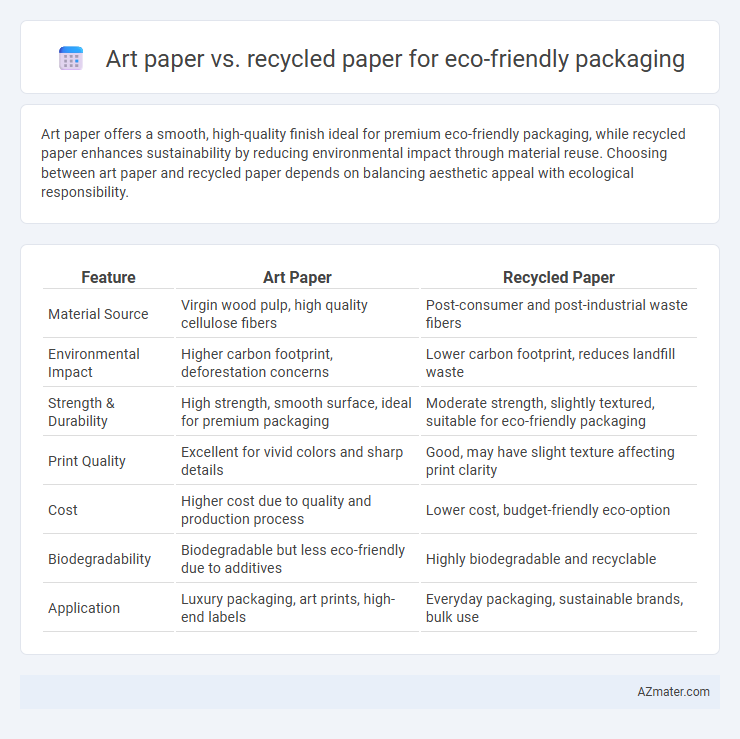Art paper offers a smooth, high-quality finish ideal for premium eco-friendly packaging, while recycled paper enhances sustainability by reducing environmental impact through material reuse. Choosing between art paper and recycled paper depends on balancing aesthetic appeal with ecological responsibility.
Table of Comparison
| Feature | Art Paper | Recycled Paper |
|---|---|---|
| Material Source | Virgin wood pulp, high quality cellulose fibers | Post-consumer and post-industrial waste fibers |
| Environmental Impact | Higher carbon footprint, deforestation concerns | Lower carbon footprint, reduces landfill waste |
| Strength & Durability | High strength, smooth surface, ideal for premium packaging | Moderate strength, slightly textured, suitable for eco-friendly packaging |
| Print Quality | Excellent for vivid colors and sharp details | Good, may have slight texture affecting print clarity |
| Cost | Higher cost due to quality and production process | Lower cost, budget-friendly eco-option |
| Biodegradability | Biodegradable but less eco-friendly due to additives | Highly biodegradable and recyclable |
| Application | Luxury packaging, art prints, high-end labels | Everyday packaging, sustainable brands, bulk use |
Introduction to Eco-Friendly Packaging Solutions
Art paper offers a smooth, high-quality surface ideal for vibrant printing in eco-friendly packaging, enhancing brand appeal while supporting sustainability when sourced responsibly. Recycled paper significantly reduces environmental impact by minimizing waste and conserving natural resources, making it a preferred choice for sustainable packaging solutions. Selecting between art paper and recycled paper depends on balancing aesthetic requirements with ecological benefits to achieve effective eco-friendly packaging.
Understanding Art Paper: Features and Uses
Art paper, known for its smooth finish and high brightness, is widely used in eco-friendly packaging due to its excellent printability and attractive appearance. Its coating enhances durability and ink absorption, making it ideal for premium product packaging that demands vibrant graphics and sharp details. Despite being less recycled, art paper can be sourced from sustainably managed forests, contributing to environmentally conscious packaging solutions.
What is Recycled Paper? Advantages and Limitations
Recycled paper is produced from recovered paper fibers, reducing the need for virgin materials and conserving natural resources. Its advantages include lowering energy consumption, decreasing landfill waste, and minimizing deforestation, making it a sustainable choice for eco-friendly packaging. Limitations involve potential variations in strength, texture, and print quality compared to art paper, which may affect durability and aesthetic appeal in packaging applications.
Environmental Impact: Art Paper vs Recycled Paper
Recycled paper significantly reduces environmental impact by minimizing deforestation and lowering energy consumption during production compared to art paper, which often involves intensive processing and chemical treatments. The use of recycled fibers decreases landfill waste and greenhouse gas emissions, promoting a circular economy in eco-friendly packaging. Although art paper offers superior print quality, recycled paper is the more sustainable choice for reducing carbon footprint and conserving natural resources.
Aesthetic and Printing Quality Comparison
Art paper offers superior smoothness and brightness, enhancing color vibrancy and sharpness, which is ideal for high-end, aesthetically appealing eco-friendly packaging. Recycled paper typically has a rougher texture and muted tones, which may result in less precise printing but conveys a strong environmental message through its sustainable origin. Choosing between the two depends on balancing premium visual impact with genuine eco-conscious branding needs.
Strength and Durability for Packaging Needs
Art paper offers superior strength and durability for eco-friendly packaging due to its high-quality fibers and dense structure, making it ideal for protecting delicate or heavy products. Recycled paper, while environmentally sustainable, often has shorter fibers resulting in lower tensile strength and less resistance to tearing, which may limit its use in packaging that requires robust protection. Selecting art paper enhances structural integrity in packaging applications, whereas recycled paper's performance can be improved through blending with virgin fibers or advanced coatings.
Cost Differences: Production and Procurement
Art paper generally incurs higher production and procurement costs due to its premium quality, smooth finish, and extensive processing requirements, often involving bleached fibers and chemical treatments. Recycled paper for eco-friendly packaging offers cost advantages by utilizing post-consumer waste streams, reducing raw material expenses and energy consumption during manufacturing. The balance between initial investment and environmental benefits positions recycled paper as a more economically sustainable choice despite potential performance trade-offs.
Consumer Perception and Branding Benefits
Art paper offers a smooth, high-quality finish that enhances brand prestige and attracts eco-conscious consumers seeking premium packaging. Recycled paper appeals to environmentally aware buyers by emphasizing sustainability and reduced environmental impact, reinforcing a green brand image. Consumer perception favors art paper for luxury appeal, while recycled paper strengthens trust and loyalty through authentic eco-friendly messaging.
Sustainability Certifications and Standards
Art paper with FSC (Forest Stewardship Council) or PEFC (Programme for the Endorsement of Forest Certification) certification ensures sustainably managed forests, minimizing environmental impact. Recycled paper often carries certifications like Blue Angel or Cradle to Cradle, highlighting its reduced resource consumption and waste generation. Both paper types contribute to eco-friendly packaging, but certification standards guarantee transparency and adherence to ecological best practices.
Choosing the Right Paper for Your Eco-Friendly Packaging
Art paper offers a smooth surface and vibrant print quality, making it ideal for premium eco-friendly packaging that requires visual appeal and durability. Recycled paper, made from post-consumer waste, significantly reduces environmental impact by conserving resources and minimizing landfill contribution, suitable for brands emphasizing sustainability. Choosing the right paper depends on balancing eco-friendliness with print quality and brand messaging to effectively communicate commitment to environmental responsibility.

Infographic: Art paper vs Recycled paper for Eco-friendly packaging
 azmater.com
azmater.com